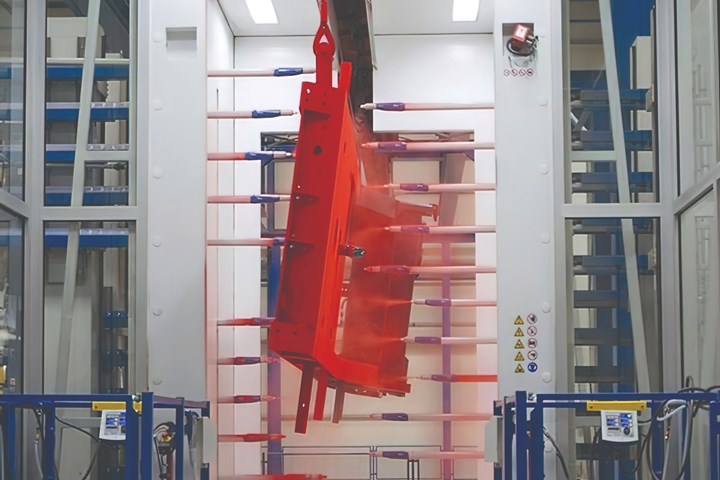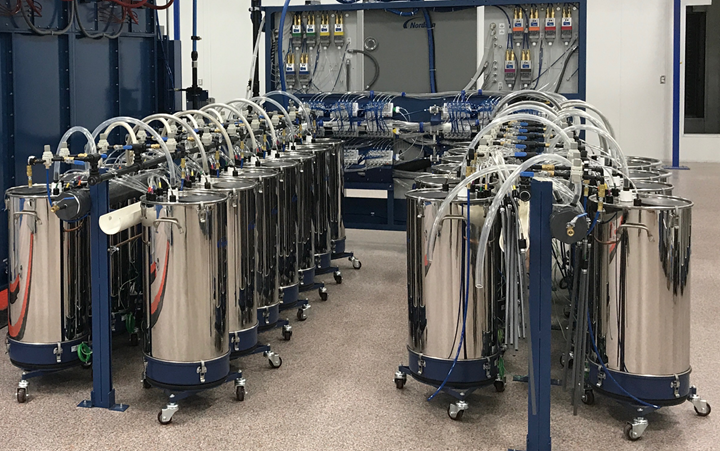Powder Coating 4.0: Smarter, Faster, More Efficient and Connected
New tools reduce cost and waste, lower manufacturing footprint of powder coating operations.

The tools of lean manufacturing and Industry 4.0 are already reshaping the powder coating segment, helping manufacturers increase equipment connectivity, better control process steps while collecting, analyzing, and visualizing data in different ways that make it easier to compare and contrast present and past process cycles and how they compare to production goals. In turn, this is helping manufacturers and finishers identify and clear bottlenecks, reduce energy and water usage, increase throughput, and improve process efficiency at a time when they are under significant pressure to control costs, use more benign technology, lower manufacturing’s carbon footprint, and improve quality. The four companies profiled here are each contributing to improvements in this important effort.

Nordson Corp. Encore HD Color-On-Demand with HDLV (high-density powder, low air flow) technology provides contamination-free color changes in less than 20 seconds. With the ability to accommodate up to 28 colors at one time, this system drives more color changes per shift, higher throughput, less waste, and an overall increase in production efficiencies for high-product mix coating operations. Photo Credit: Nordson Corp.
Improving Process Efficiency
The Industrial Coatings Systems Div. of Nordson Corp. (Westlake, Ohio) is a global leader in application and curing equipment for powder coating and liquid spray painting, container coatings, and precision dispensing equipment. Major market segments include automotive, mining, agricultural equipment, architecture, furniture, and marine.
Featured Content
As an early leader in powder coating, Nordson produces a broad range of manual and automatic equipment, including venturi and high-density/low-velocity (HDLV) pumps; advanced electrostatic controls capable of managing nano-currents to an accuracy of 0.1 microamps even with metallic powders; spray systems capable of color changes in less than 20 seconds for non-reclaim systems and only a few minutes for systems that reclaim powder; and advanced/Industry 4.0-compliant controllers that track and record a range of operating data enabling greater quality and process control and permitting quick remote troubleshooting by Nordson engineers. The company’s entire product line is said to have “smart” elements capable of adaptive control and collecting, recording, and monitoring/analyzing data that is then provided to a user. Additionally, all equipment complies with relevant global standards, permitting use in nearly any geography.
“The demand for smart powder coating technology is growing globally,” explains Kyle Steele, Nordson product portfolio manager-powder coating. “The European Union has focused on lowering environmental impacts and better managing big data for a long time, and those trends are becoming important in North America too. Plus, with China committing to being carbon neutral by 2060, we see interest in Asia growing as well. Since we’re committed to remaining a technology leader, we closely watch trends and then drive to innovate in that space.”
“Not everyone opts to use the sophistication, but all of our systems can collect and share data,” adds Jim Khoury, Nordson engineering manager-software electrical electrocoating systems. “Depending on what you’re doing with the data, there is lots of room for material and energy savings. However, smart technology also makes your process more consistent from shift-to-shift, which represents additional savings in terms of transfer efficiency and system optimization.”
“Our customer base is broad and diverse, which is why we offer the scalability to move from manual to fully automatic systems and components,” continues Dan Bowens, Nordson commercial labs supervisor. “We have a lot of intellectual property tied up in patents and we’re always looking for new ideas and concepts to improve process efficiency. A good example is automatically detecting when no part is coming down the conveyor belt, which means that both electrical and pneumatic energy can be scaled back, ultimately leading to savings all around. All these smart features help support lean manufacturing as, no matter the size of a facility, everyone wants to save money.”
Increasing Connectivity

Among the broad offering of manual and automatic powder coating equipment and complete systems that Gema offers are its MagicCompact Equiflow XXL booths for powder coating very large parts — in this case, an agricultural equipment frame.
Photo Credit: Gema USA Inc.
Gema USA Inc. (Indianapolis, Ind.) is a global supplier of electrostatic powder coating equipment, including automatic and manual booth systems, equipment, and guns; reciprocators; sieves; powder-feeding equipment, management centers, and hoppers; electrostatic equipment and systems; controllers; and automation. The company has several facilities throughout Europe, North America, and Asia and supports customers via a network of distributors in 60 countries. Customers represent a broad swathe of the powder coating segment, including metalworking, stands/racking/shelving, sports and leisure, lawn and garden, architecture, furniture, lighting, automotive, agricultural/off-highway, heating/ventilation/air conditioning, medical equipment, large appliance, truck, electrical/power, and pipe. Since 2012, Gema has been a member of the Graco Group, a global supplier of fluid conveyance and control systems.
Gema says that customers in all the major market segments the company participates in are interested in some amount of smart technology. As companies attempt to implement Industry 4.0 technology at various levels, some are installing sensors and communication devices on legacy finishing and powder coating equipment while others are purchasing new equipment specifically designed with smart functionality.
“Historically, many products, machines, and equipment have told us one thing — what has already happened — but today we want them to be smarter and to tell us two things — what is about to happen and how we can avoid it if we don’t like it,” says Jeffrey Hale, Gema USA marketing director. “As we move closer to smart factories, we need to gather and analyze data faster and more efficiently to help us make better decisions quicker. Still, the reality is that most smart systems today gather, analyze, and report information but rely on the user to make adjustments to improve performance.”
Hale explains that each of Gema’s automated systems that incorporates control software also uses smart sensors to gather data. And the company’s manual and automatic powder guns are Bluetooth compatible, enabling users to connect, via smartphone/tablet app, to a specific gun controller to view data like powder consumption and productivity data on a daily, weekly, or annual basis.
“If the end user is willing to bring an internet connection to the main control panel, then our system can pass data securely to the Cloud, enabling data and key performance indicators [KPIs] to be reviewed in real time from any location and any device accessing the internet via a web browser,” he adds. “Those end users taking advantage of this feature are utilizing our GemaConnect Dashboard, which is our new digital production information platform for monitoring, visualizing, and analyzing production data in real time. It’s designed to provide operators, managers and supervisors, and maintenance personnel with full transparency and remote access to valuable information using their web browser. It’s ideal for any company desiring to improve overall operational efficiency, maximize resources, and reduce operating costs.” For data security reasons, data passes in only one direction (to but not from the Cloud) and users are only able to view data. For operational safety reasons, start/stop or parameter adjustments can only be made at the machine, not from the GemaConnect dashboard.
Not Just for Giga Industries
Springer Industrial Equipment (Chandler, Az.) designs and installs complete finishing systems plus supplies manual and automatic equipment for liquid/electrostatic and powder-coating operations, spray booths/ovens, abrasive blasting and sanitizing equipment, and automation systems/conveyors. Key markets include agricultural equipment, marine and automotive components, industrial/building materials, and consumer products in a geography covering the Southwestern U.S. and Northern Mexico. The company sees a number of trends shifting the market toward smart finishing technology, including high labor and material costs, challenges finding skilled labor, stricter environmental regulations, and a race to automate. All equipment Springer sells has smart features and the company reports return on investment (ROI) can be as short as three months.
“We look at [Industry] 4.0 as a no-fix tooling/on-demand labor force that scales for future growth,” explains David Springer, president, Springer Industrial. “Part recognition technology is a real asset to customers as this technology recognizes a part and knows the right coating thickness to apply without it having to be programmed in manually, a feature that is only growing in importance given the challenge of finding skilled workers. Also, smart systems are connected systems, which facilitate everything from programming to accessing data to controlling equipment remotely, and even completing environmental reporting.” The technology enables companies to track productivity; increase repeatability and quality; reduce defects, rework, cleanup, and downtime; lower labor, energy, and material costs; and improve efficiency. “In short, ‘smart’ technology enables companies to make smarter decisions with less labor and human interference,” he adds.
While highly competitive industries like automotive are already embracing smart powder coating technology, Springer notes that smaller finishers should also be considering it, since interfaces are becoming more seamless, and smart technology can help technicians troubleshoot and get lines back up and running more quickly without having to wait days for a technician to physically arrive at a plant.
“Everyone needs access to more data these days and even manual controllers can collect data and help operators digest information more easily,” Springer adds. “Smart technology helps smaller shops with job costing, access to labor, materials, trigger time, and helps companies understand whether they’re making or losing money. Fortunately, you don’t have to abandon everything you have to make painting processes smarter as there are incremental steps you can take to get there. Doing nothing, however, ensures your competitors will get more competitive and will eventually price you out of the market.” He notes that one technology gap the industry needs to address is better simulations of finishing equipment.
The Basis for Industry 4.0

IntelliFinishing reports that with its systems, it’s common to provide two or more lanes of ovens, which permits faster drying or curing parts in certain carriers to bypass slower-moving carriers whose parts require longer cycles, increasing total throughput/hour. Similar options are said to be available for other processes ranging from booths to masking to spurs in order to better control QA objectives.
Photo Credit: IntelliFinishing, a div. of Kasa companies
IntelliFinishing (Salina, Kan.), a div. of Kasa companies — itself well-known for its automotive control systems — is a complete supplier of automated finishing systems for both liquid and powder coating operations. It provides a full range of patented and energy-efficient products, including controls, conveyors, washers, ovens, coating systems, and robots, plus services ranging from design and project management through installation and commissioning. Automotive, aerospace, agricultural equipment, military/defense, and construction are key served markets.
The company cites its modular, chain-free, friction-drive conveyor system and smart controls technologies as key enablers for IntelliFinishing’s recipe-driven approach to finishing-system design and customer success. The space- and energy-efficient system permits individual sections of the conveyor, powered by small motors, to move independently in both directions and at different speeds with the ability to precisely stop/start as required. For example, unlike most monorails, which operate continuously at a set feet/minute rate, sections of IntelliFinishing’s conveyor only move when a carrier is present, so conveyor motors and wash, dry, and bake functions cycle on/off as needed, reducing utility usage. This ability to independently control movement and timing of each cycle in the process also reduces unintended consequences such as occur when the whole line is slowed down to provide a longer bake but extends wash/dry cycles that can lead to flash rust, or by speeding up earlier sections of the process, leading to underbaking during the cure cycle. The system’s flexibility also permits a broader range of part sizes, thicknesses, and recipes to be processed on the same equipment, plus its inherent modularity also makes the system scalable and easy to change or expand over time. And unlike chain systems, which are often welded in place, IntelliFinishing says its modular conveyors are bolted together, permitting modification with little downtime — frequently by just changing recipe programming.
“IntelliFinishing systems are inherently smart systems, since we power each carrier of products and each section of track through the system, and we control all those motors using our software and sensor systems so we know where every carrier is at all times and we know what movement and process the carrier requires per section of track,” explains John Claman, IntelliFinishing sales representative and marketing supervisor. “At its heart, this is the basis of Industry 4.0: connecting various systems into a more integrated control and reporting process rather than using many unrelated systems that cannot communicate or report data in a unified manner.”
The company relies on programmable logic controllers (PLCs) and overriding server-housed supervisory control and data acquisition (SCADA) software called Ignition from Inductive Automation, LLC (Folsom, Calif.) for an operating system. “Ignition is state-of-the-art industrial control software that’s known for its ease of use, modular capacity, and ability to permit users to integrate unlimited tags/datapoints, clients (onsite and remote networked user terminals), and connections to other databases,” Claman continues. “Ignition not only provides our system with connectivity to each system PLC, but also to systems outside the finishing system, such as ERP (enterprise resource planning), HR (human relations) time systems, and MPR (material resource planning) or other systems.” He adds that information about each carrier’s recipe as well as what actually happened to each carrier as it was processed is logged historically and can be used to produce custom reports and human/machine interface (HMI) screen displays, helping operators and supervisors better understand what the system is doing from a micro to a macro level, including real-time system performance comparisons to goals and expectations.
“The thing to remember is that just having a smart paint booth is not enough,” Claman adds. “It’s a start, for sure, but it’s not sufficient to guarantee high quality and high throughput. A finishing system that doesn’t do pretreatment or curing processes well can still cause premature finish failures no matter how well the smart robot or reciprocator coats the product. A truly smart finishing system will not only be better able to adapt to a broader range of part sizes and thicknesses, plus new recipes, processes, and materials — perhaps some that haven’t even been invented yet — but it may also require less pretreatment, use more environmentally friendly chemicals, reduce energy and water usage, shorten curing times, and increase system uptime. It will also provide payoff in terms of operating cost savings, higher quality finishing, and increased throughput.”
About the Author

Peggy Malnati
Peggy Malnati regularly writes for PF sister publications CompositesWorld and MoldMaking Technology magazines. pmalnati@garpub.com
RELATED CONTENT
-
Developments and Trends in Powder Coating
New solutions for powder coating centers combine powder preparation, conveyance, dosing and color changes into a fully automated, closed system.
-
Powder Coat MDF for an Enviable Finished Product
Cabinet maker says powder coating on wood offers more benefits.
-
Preparation of Stainless Steel for Powder Coating
Should type 316 stainless steel castings be sandblasted before powder coating, or can they be chemically etched? Should the parts be pre-heated in an oven before coating?



















